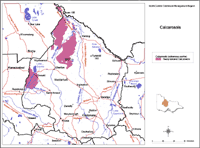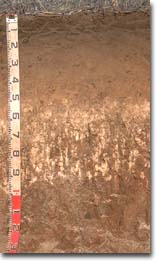Calcarosols
|
| Calcarosols have gradational texture profiles with abundant carbonates at depth. Colour is mostly red brown and the subsoils are sodic. They occur in the north-western calcareous dune fields, and can be subdivided according to texture. Ligh-textured Calcarosols occur in the north west where E-W sand dunes alternate with broad swales which have loamy surfaces and clay subsoils. The contrasting soils pose difficulties in farm management, the dunes having lower fertility and higher erosion hazard. Heavy-textured Calcarosols occur further to the south where E-W dunes are infrequent or replaced by sub-round hummocks. Soils on upper hummocks and stranded ridge slopes have loamy surfaces. The lower slopes and plains have clay loam to light clay surfaces (thus grading into Vertosols). The upper metre or so is permeable, but the underlying pedoderms tend to have low permeability. The land is relatively fertile, stable and productive. |
| This map of Calcarosols in the North Central region has been developed by Jim Rowan and is based on the Land Systems of Victoria (1:250 000). It shows areas where Calcarosols are most likely to occur within the region. Note that other soil types may also occur within these mapped areas (although they are likely to be a more minor component). |  Calcarosols North Central Region |



